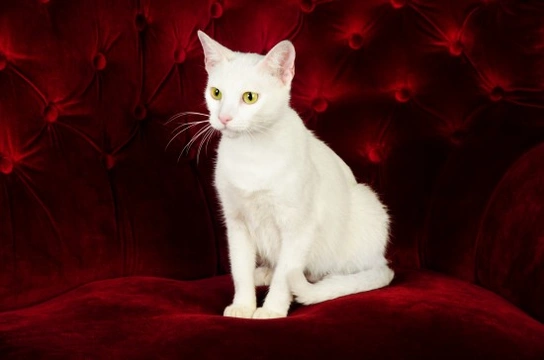
Some frequently asked questions about the Khao Manee cat breed
The Khao Manee cat is also referred to as the “Diamond Eye” cat, and originates in Thailand with a known breed history going back for hundreds of years. Despite this, the breed is still relatively rare worldwide, and has only begun to be recognised in other countries and promoted outside of Thailand within the last decade.
The Khao Manee is a very distinctive cat, with short, smooth white fur and an athletic, oriental appearance. The eyes of the cat can be either gold, blue, or one of each, with the odd-eyed variant considered to be the preferred type for the breed.
Thanks to their good looks, kind natures and appealing tempers, as well as attempts to promote the breed in the UK and USA, the Khao Manee is one of the fastest growing rare breeds within the UK today. However, not much information is widely available on the breed outside of that provided by their professional breeders, and so in this article, we will cover some of the most frequently asked questions about the Khao Manee cat breed. Read on to learn more.
Is the Khao Manee a recognised pedigree breed?
The International Cat Association (TICA) recognised the Khao Manee for registration as a preliminary new breed in 2012, and as an advanced new breed in 2013. This places the Khao Manee in the middle of the process for gaining full formal recognition as a pedigree breed in its own right with TICA.
The GCCF (Governing Council of the Cat Fancy) approved the breed name in 2010, and pre-affiliation in 2011, so while the breed is not as of yet fully recognised in the UK with the GCCF, again, it is well on its way to full accreditation.
What is their temperament like?
The Khao Manee can fairly be described as a relatively vocal cat, a trait that they share with another Thai cat breed, the Siamese. They tend to be chatty with their owners and have a wide range of vocalisations for every occasion, and some owners are adamant that their meows form their own distinctive language!
They have bold, inquisitive natures and like to explore; a closed door or out of bounds area is likely to be seen as a challenge, and they do not like being restricted in terms of what they are allowed to do! They also have well-honed hunting instincts, and if permitted to go outside, may well bring you back little “presents.”
The Khao Manee is also renowned for being very good tempered and enjoying the company of people, and they tend to bond strongly with their families. They also like older, well behaved children, and anyone who is willing to offer them space on their laps! They do not like to be left alone for long periods of time, and enjoy having company, whether that be human company or that of another cat. They also live quite happily side by side with dogs, and will often befriend kind dogs that share their home!
Are they deaf?
It is well known that a white coat colouration combined with one or two blue eyes often comes accompanied by a propensity to deafness, and deafness can and does occur within the Khao Manee cat breed. However, it is not thought that blue eyed or odd eyed cats of the breed as quite as prone to genetic deafness as most other breeds with the same coat/eye colour combination, although definitive figures for deafness within the breed have not yet been produced.
The Khao Manee is currently the subject of formal research within the USA in order to determine the prevalence rate of hereditary deafness across the breed, although research such as this takes a significant amount of time, and has not yet been completed.
Are they healthy?
Again, due to the relative rarity of the breed outside of Thailand and the fact that research into the breed has only recently begun, not a huge amount is currently known about the overall health and longevity of the Khao Manee cat breed.
However, considering their purebred status, they are not known as yet to be particularly prone to a high level of genetically inherited health problems, possibly due to the fact that the breed has been established for hundreds of years and is considered to be relatively diverse.
Incidences of deafness do arise within the breed, which may or not be connected to the white coat/blue eye combination (see above) and all cats with white fur may be at heightened risk of problems such as sun burn and skin cancer, due to their light coats and pink skin.
One flaw or issue that does arise within the breed with a reasonable amount of regularity is a kinked tail, but this is currently viewed as more of a breed standard flaw than being something that has been definitively linked to any problems with the spine or bone development.



